Engineering Secondary and Finishing Techniques Report - Unit 21
VerifiedAdded on 2023/03/21
|24
|5019
|21
Report
AI Summary
This report provides a detailed overview of engineering secondary and finishing techniques, focusing on surface hardening of steels, assembly techniques, and finishing methods like anodizing and plating. Surface hardening methods, including diffusion techniques such as carburizing, carbonitriding, nitriding, and nitrocarburizing, as well as energy methods like flame and induction hardening, are discussed. The report also covers manual and automated assembly processes, highlighting the use of screwed fasteners, locking devices, and modularity techniques. Furthermore, it examines anodizing and plating methods, detailing their advantages and applications in enhancing metal surface properties. Desklib offers this and many other solved assignments.
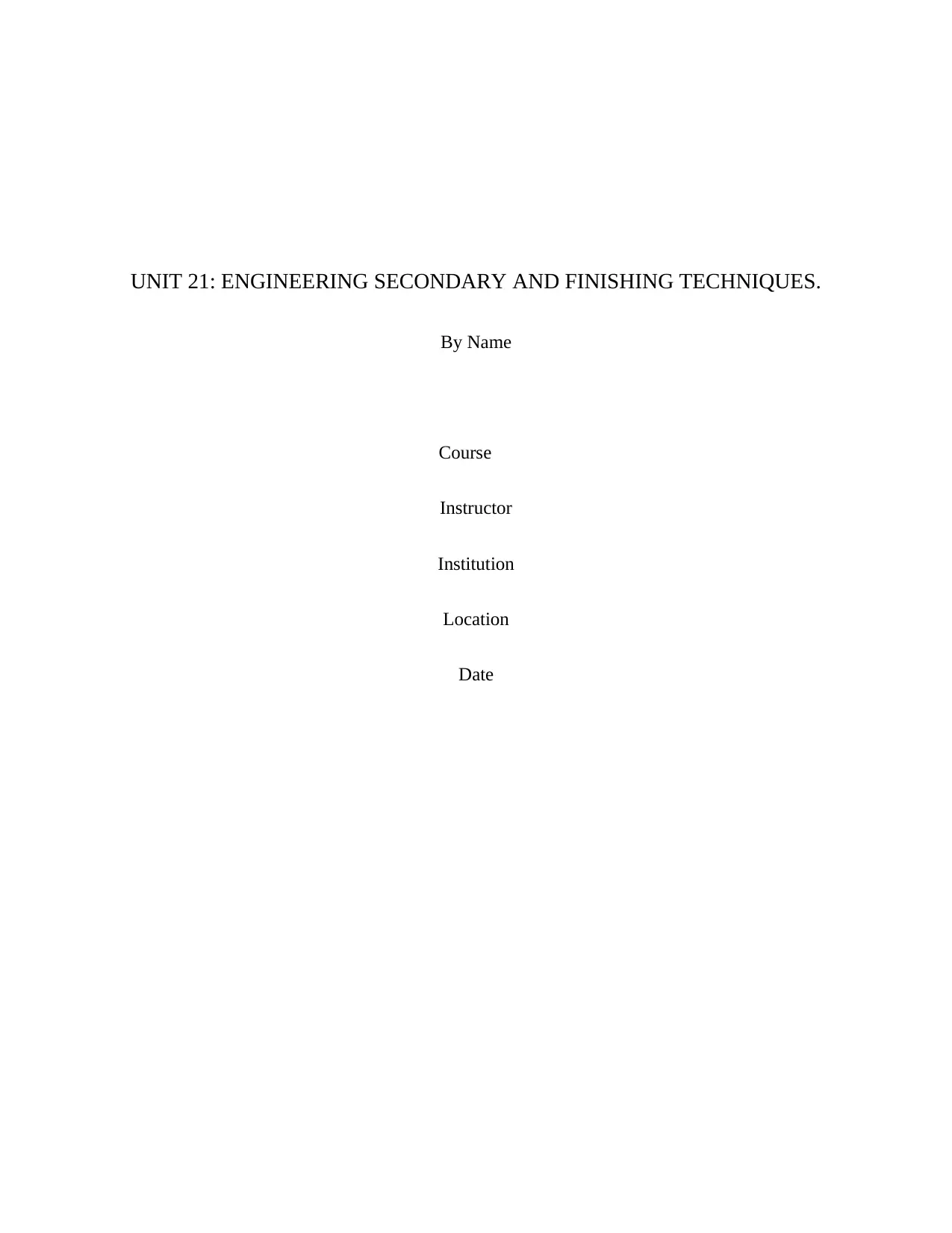
UNIT 21: ENGINEERING SECONDARY AND FINISHING TECHNIQUES.
By Name
Course
Instructor
Institution
Location
Date
By Name
Course
Instructor
Institution
Location
Date
Paraphrase This Document
Need a fresh take? Get an instant paraphrase of this document with our AI Paraphraser
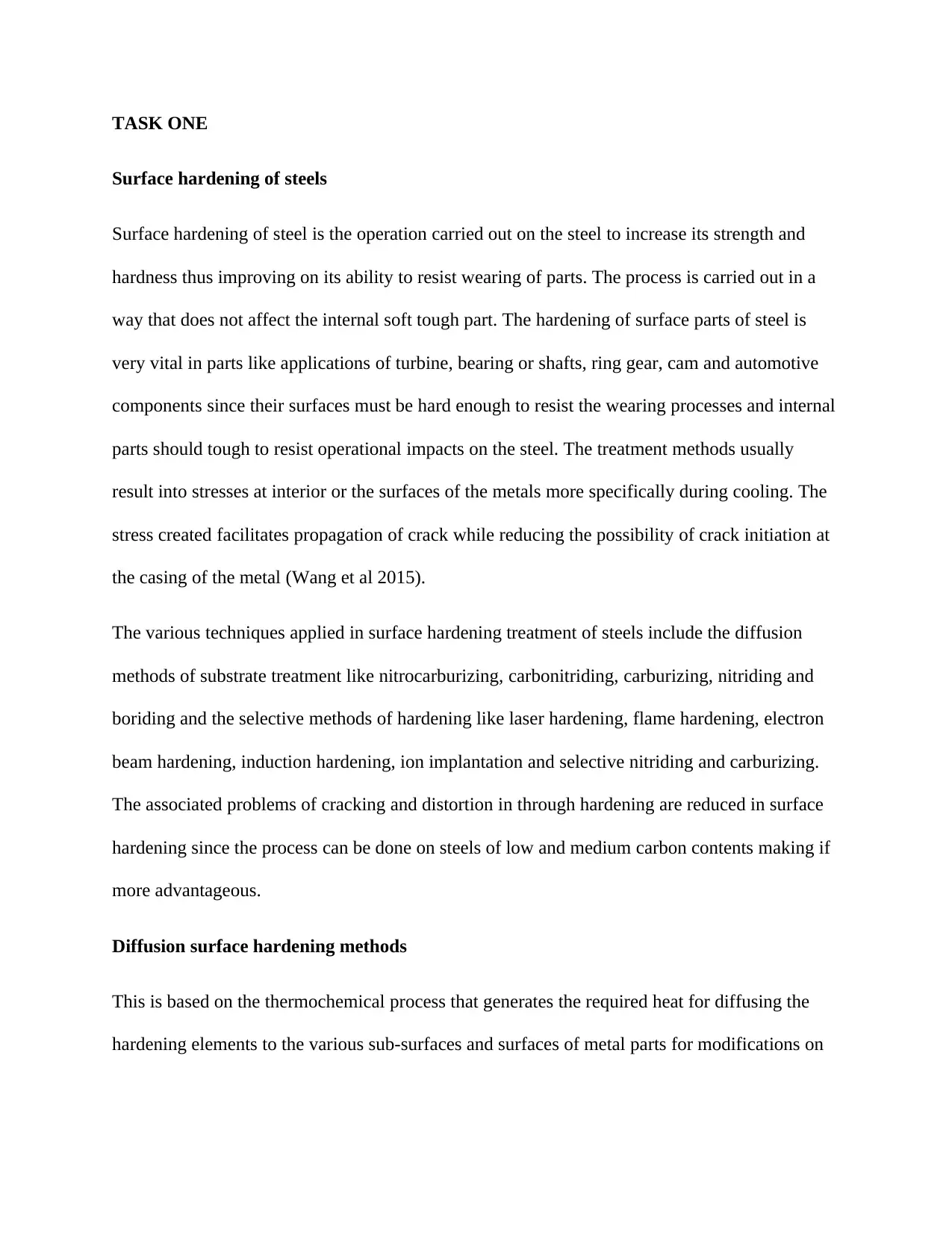
TASK ONE
Surface hardening of steels
Surface hardening of steel is the operation carried out on the steel to increase its strength and
hardness thus improving on its ability to resist wearing of parts. The process is carried out in a
way that does not affect the internal soft tough part. The hardening of surface parts of steel is
very vital in parts like applications of turbine, bearing or shafts, ring gear, cam and automotive
components since their surfaces must be hard enough to resist the wearing processes and internal
parts should tough to resist operational impacts on the steel. The treatment methods usually
result into stresses at interior or the surfaces of the metals more specifically during cooling. The
stress created facilitates propagation of crack while reducing the possibility of crack initiation at
the casing of the metal (Wang et al 2015).
The various techniques applied in surface hardening treatment of steels include the diffusion
methods of substrate treatment like nitrocarburizing, carbonitriding, carburizing, nitriding and
boriding and the selective methods of hardening like laser hardening, flame hardening, electron
beam hardening, induction hardening, ion implantation and selective nitriding and carburizing.
The associated problems of cracking and distortion in through hardening are reduced in surface
hardening since the process can be done on steels of low and medium carbon contents making if
more advantageous.
Diffusion surface hardening methods
This is based on the thermochemical process that generates the required heat for diffusing the
hardening elements to the various sub-surfaces and surfaces of metal parts for modifications on
Surface hardening of steels
Surface hardening of steel is the operation carried out on the steel to increase its strength and
hardness thus improving on its ability to resist wearing of parts. The process is carried out in a
way that does not affect the internal soft tough part. The hardening of surface parts of steel is
very vital in parts like applications of turbine, bearing or shafts, ring gear, cam and automotive
components since their surfaces must be hard enough to resist the wearing processes and internal
parts should tough to resist operational impacts on the steel. The treatment methods usually
result into stresses at interior or the surfaces of the metals more specifically during cooling. The
stress created facilitates propagation of crack while reducing the possibility of crack initiation at
the casing of the metal (Wang et al 2015).
The various techniques applied in surface hardening treatment of steels include the diffusion
methods of substrate treatment like nitrocarburizing, carbonitriding, carburizing, nitriding and
boriding and the selective methods of hardening like laser hardening, flame hardening, electron
beam hardening, induction hardening, ion implantation and selective nitriding and carburizing.
The associated problems of cracking and distortion in through hardening are reduced in surface
hardening since the process can be done on steels of low and medium carbon contents making if
more advantageous.
Diffusion surface hardening methods
This is based on the thermochemical process that generates the required heat for diffusing the
hardening elements to the various sub-surfaces and surfaces of metal parts for modifications on
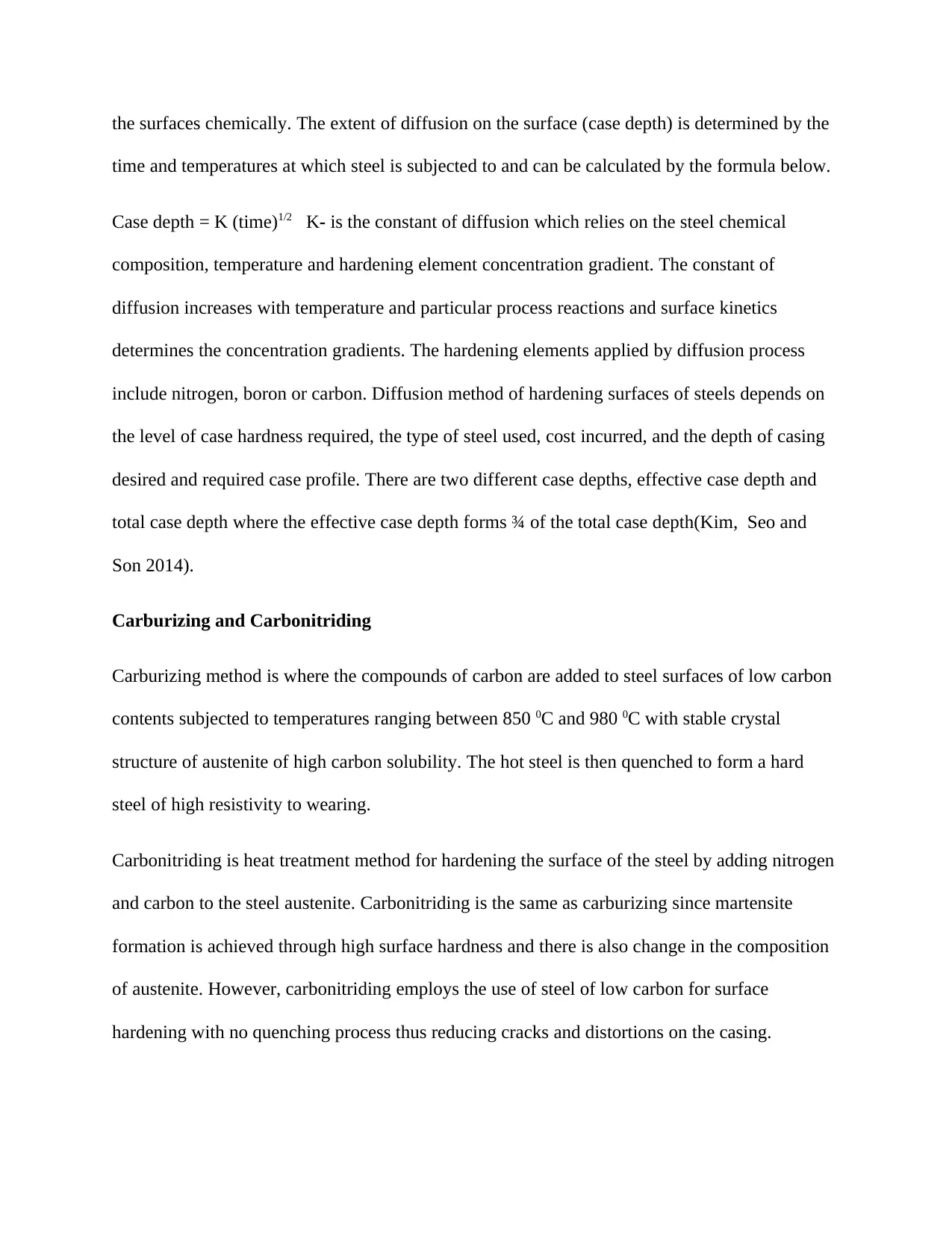
the surfaces chemically. The extent of diffusion on the surface (case depth) is determined by the
time and temperatures at which steel is subjected to and can be calculated by the formula below.
Case depth = K (time)1/2 K- is the constant of diffusion which relies on the steel chemical
composition, temperature and hardening element concentration gradient. The constant of
diffusion increases with temperature and particular process reactions and surface kinetics
determines the concentration gradients. The hardening elements applied by diffusion process
include nitrogen, boron or carbon. Diffusion method of hardening surfaces of steels depends on
the level of case hardness required, the type of steel used, cost incurred, and the depth of casing
desired and required case profile. There are two different case depths, effective case depth and
total case depth where the effective case depth forms ¾ of the total case depth(Kim, Seo and
Son 2014).
Carburizing and Carbonitriding
Carburizing method is where the compounds of carbon are added to steel surfaces of low carbon
contents subjected to temperatures ranging between 850 0C and 980 0C with stable crystal
structure of austenite of high carbon solubility. The hot steel is then quenched to form a hard
steel of high resistivity to wearing.
Carbonitriding is heat treatment method for hardening the surface of the steel by adding nitrogen
and carbon to the steel austenite. Carbonitriding is the same as carburizing since martensite
formation is achieved through high surface hardness and there is also change in the composition
of austenite. However, carbonitriding employs the use of steel of low carbon for surface
hardening with no quenching process thus reducing cracks and distortions on the casing.
time and temperatures at which steel is subjected to and can be calculated by the formula below.
Case depth = K (time)1/2 K- is the constant of diffusion which relies on the steel chemical
composition, temperature and hardening element concentration gradient. The constant of
diffusion increases with temperature and particular process reactions and surface kinetics
determines the concentration gradients. The hardening elements applied by diffusion process
include nitrogen, boron or carbon. Diffusion method of hardening surfaces of steels depends on
the level of case hardness required, the type of steel used, cost incurred, and the depth of casing
desired and required case profile. There are two different case depths, effective case depth and
total case depth where the effective case depth forms ¾ of the total case depth(Kim, Seo and
Son 2014).
Carburizing and Carbonitriding
Carburizing method is where the compounds of carbon are added to steel surfaces of low carbon
contents subjected to temperatures ranging between 850 0C and 980 0C with stable crystal
structure of austenite of high carbon solubility. The hot steel is then quenched to form a hard
steel of high resistivity to wearing.
Carbonitriding is heat treatment method for hardening the surface of the steel by adding nitrogen
and carbon to the steel austenite. Carbonitriding is the same as carburizing since martensite
formation is achieved through high surface hardness and there is also change in the composition
of austenite. However, carbonitriding employs the use of steel of low carbon for surface
hardening with no quenching process thus reducing cracks and distortions on the casing.
⊘ This is a preview!⊘
Do you want full access?
Subscribe today to unlock all pages.

Trusted by 1+ million students worldwide
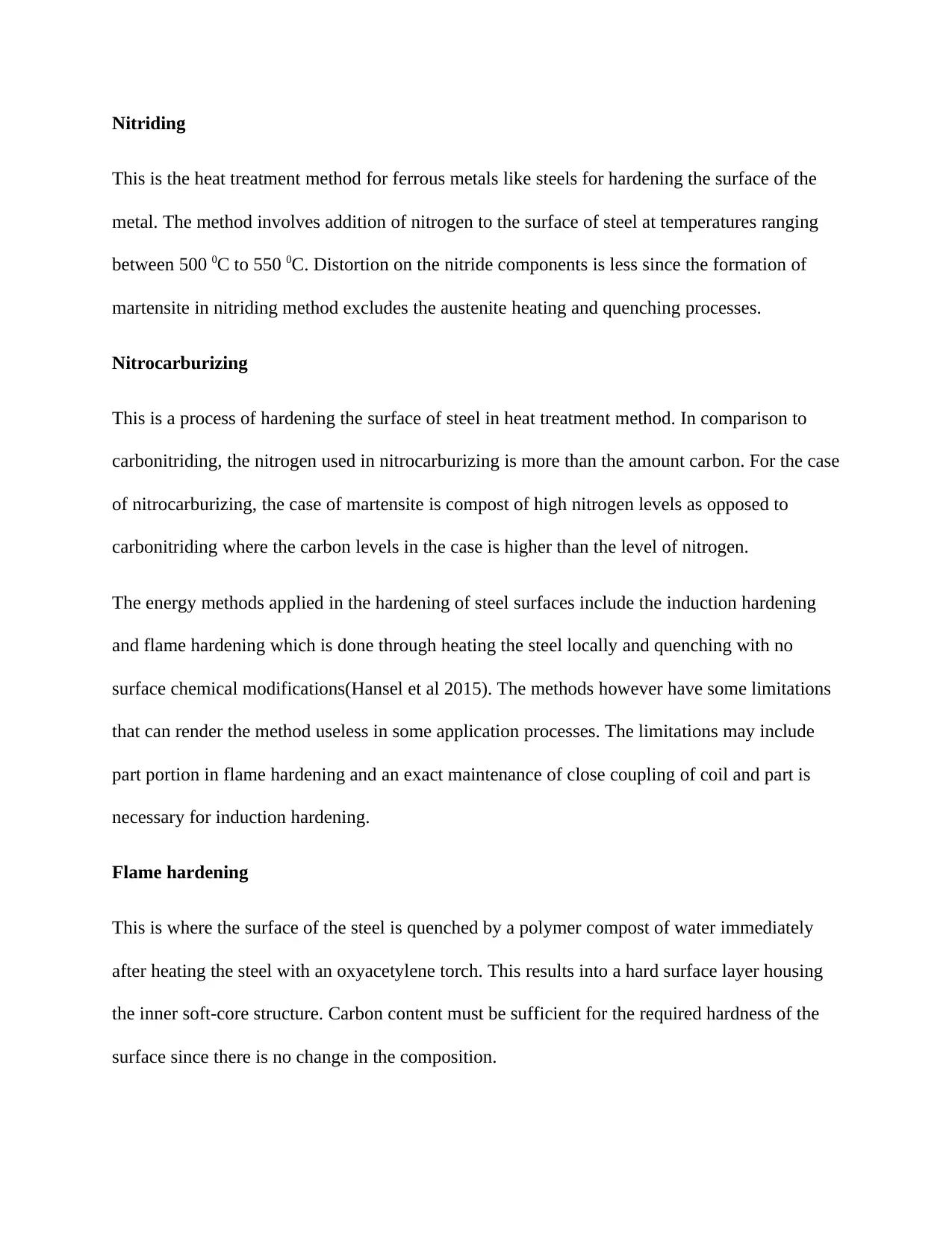
Nitriding
This is the heat treatment method for ferrous metals like steels for hardening the surface of the
metal. The method involves addition of nitrogen to the surface of steel at temperatures ranging
between 500 0C to 550 0C. Distortion on the nitride components is less since the formation of
martensite in nitriding method excludes the austenite heating and quenching processes.
Nitrocarburizing
This is a process of hardening the surface of steel in heat treatment method. In comparison to
carbonitriding, the nitrogen used in nitrocarburizing is more than the amount carbon. For the case
of nitrocarburizing, the case of martensite is compost of high nitrogen levels as opposed to
carbonitriding where the carbon levels in the case is higher than the level of nitrogen.
The energy methods applied in the hardening of steel surfaces include the induction hardening
and flame hardening which is done through heating the steel locally and quenching with no
surface chemical modifications(Hansel et al 2015). The methods however have some limitations
that can render the method useless in some application processes. The limitations may include
part portion in flame hardening and an exact maintenance of close coupling of coil and part is
necessary for induction hardening.
Flame hardening
This is where the surface of the steel is quenched by a polymer compost of water immediately
after heating the steel with an oxyacetylene torch. This results into a hard surface layer housing
the inner soft-core structure. Carbon content must be sufficient for the required hardness of the
surface since there is no change in the composition.
This is the heat treatment method for ferrous metals like steels for hardening the surface of the
metal. The method involves addition of nitrogen to the surface of steel at temperatures ranging
between 500 0C to 550 0C. Distortion on the nitride components is less since the formation of
martensite in nitriding method excludes the austenite heating and quenching processes.
Nitrocarburizing
This is a process of hardening the surface of steel in heat treatment method. In comparison to
carbonitriding, the nitrogen used in nitrocarburizing is more than the amount carbon. For the case
of nitrocarburizing, the case of martensite is compost of high nitrogen levels as opposed to
carbonitriding where the carbon levels in the case is higher than the level of nitrogen.
The energy methods applied in the hardening of steel surfaces include the induction hardening
and flame hardening which is done through heating the steel locally and quenching with no
surface chemical modifications(Hansel et al 2015). The methods however have some limitations
that can render the method useless in some application processes. The limitations may include
part portion in flame hardening and an exact maintenance of close coupling of coil and part is
necessary for induction hardening.
Flame hardening
This is where the surface of the steel is quenched by a polymer compost of water immediately
after heating the steel with an oxyacetylene torch. This results into a hard surface layer housing
the inner soft-core structure. Carbon content must be sufficient for the required hardness of the
surface since there is no change in the composition.
Paraphrase This Document
Need a fresh take? Get an instant paraphrase of this document with our AI Paraphraser
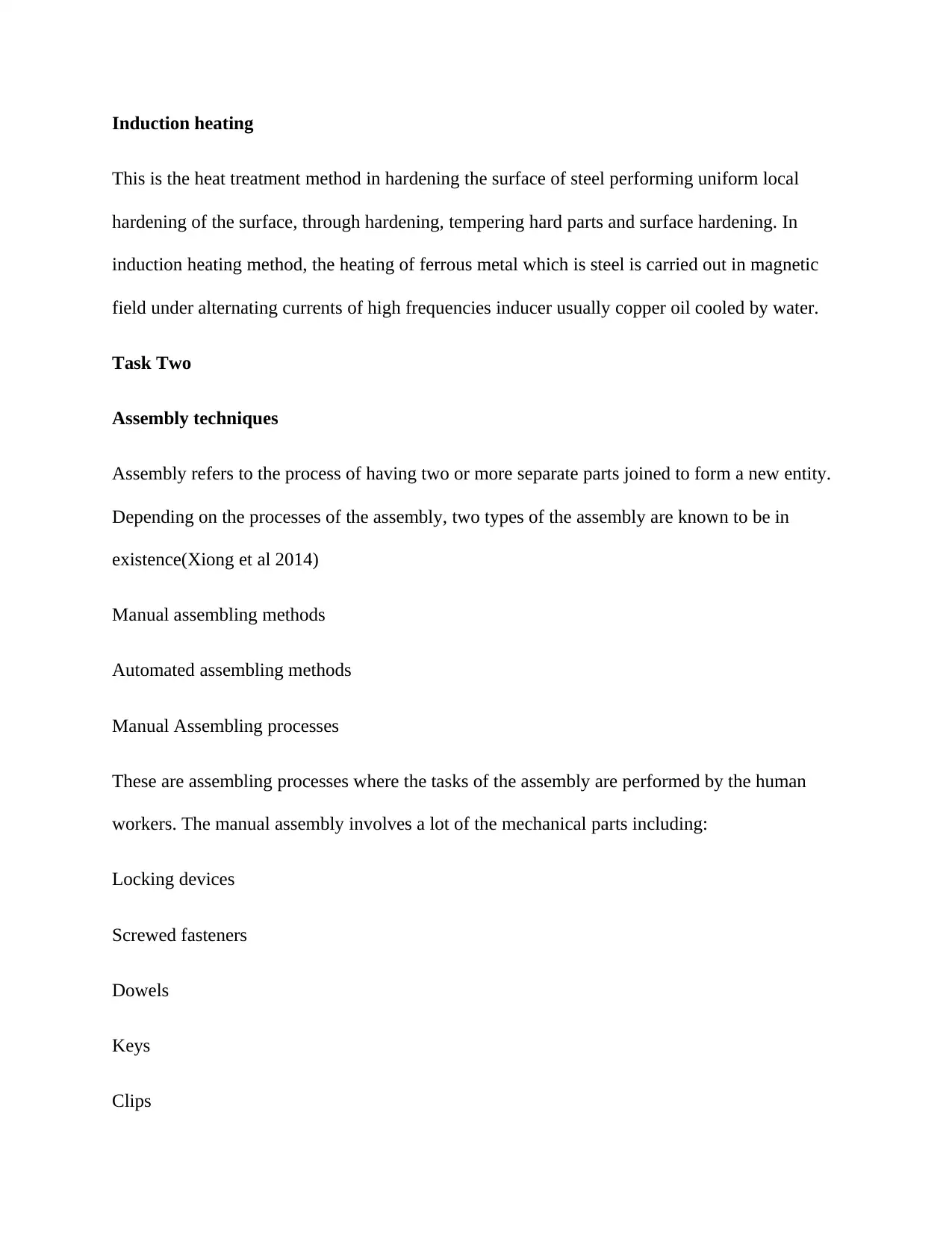
Induction heating
This is the heat treatment method in hardening the surface of steel performing uniform local
hardening of the surface, through hardening, tempering hard parts and surface hardening. In
induction heating method, the heating of ferrous metal which is steel is carried out in magnetic
field under alternating currents of high frequencies inducer usually copper oil cooled by water.
Task Two
Assembly techniques
Assembly refers to the process of having two or more separate parts joined to form a new entity.
Depending on the processes of the assembly, two types of the assembly are known to be in
existence(Xiong et al 2014)
Manual assembling methods
Automated assembling methods
Manual Assembling processes
These are assembling processes where the tasks of the assembly are performed by the human
workers. The manual assembly involves a lot of the mechanical parts including:
Locking devices
Screwed fasteners
Dowels
Keys
Clips
This is the heat treatment method in hardening the surface of steel performing uniform local
hardening of the surface, through hardening, tempering hard parts and surface hardening. In
induction heating method, the heating of ferrous metal which is steel is carried out in magnetic
field under alternating currents of high frequencies inducer usually copper oil cooled by water.
Task Two
Assembly techniques
Assembly refers to the process of having two or more separate parts joined to form a new entity.
Depending on the processes of the assembly, two types of the assembly are known to be in
existence(Xiong et al 2014)
Manual assembling methods
Automated assembling methods
Manual Assembling processes
These are assembling processes where the tasks of the assembly are performed by the human
workers. The manual assembly involves a lot of the mechanical parts including:
Locking devices
Screwed fasteners
Dowels
Keys
Clips
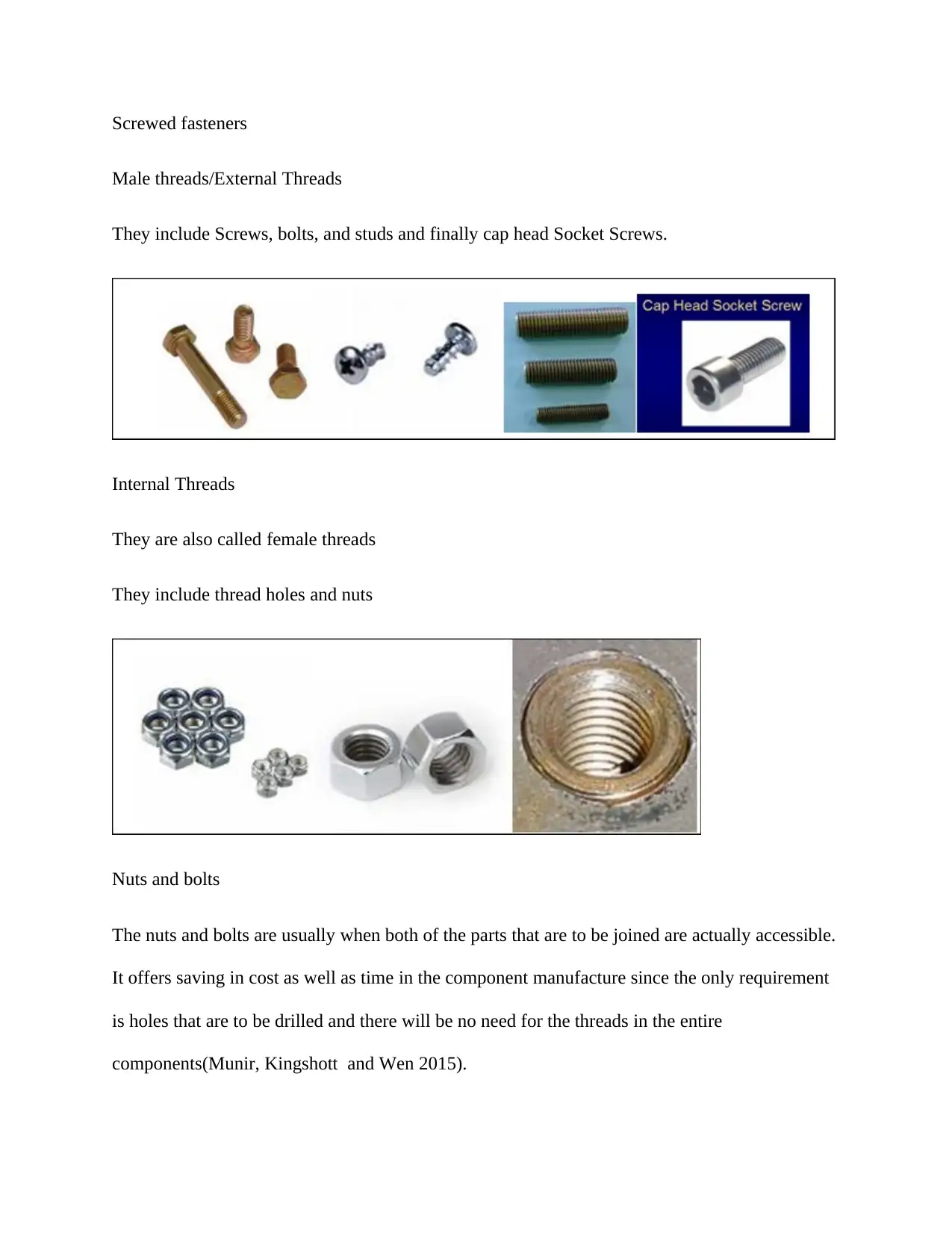
Screwed fasteners
Male threads/External Threads
They include Screws, bolts, and studs and finally cap head Socket Screws.
Internal Threads
They are also called female threads
They include thread holes and nuts
Nuts and bolts
The nuts and bolts are usually when both of the parts that are to be joined are actually accessible.
It offers saving in cost as well as time in the component manufacture since the only requirement
is holes that are to be drilled and there will be no need for the threads in the entire
components(Munir, Kingshott and Wen 2015).
Male threads/External Threads
They include Screws, bolts, and studs and finally cap head Socket Screws.
Internal Threads
They are also called female threads
They include thread holes and nuts
Nuts and bolts
The nuts and bolts are usually when both of the parts that are to be joined are actually accessible.
It offers saving in cost as well as time in the component manufacture since the only requirement
is holes that are to be drilled and there will be no need for the threads in the entire
components(Munir, Kingshott and Wen 2015).
⊘ This is a preview!⊘
Do you want full access?
Subscribe today to unlock all pages.

Trusted by 1+ million students worldwide
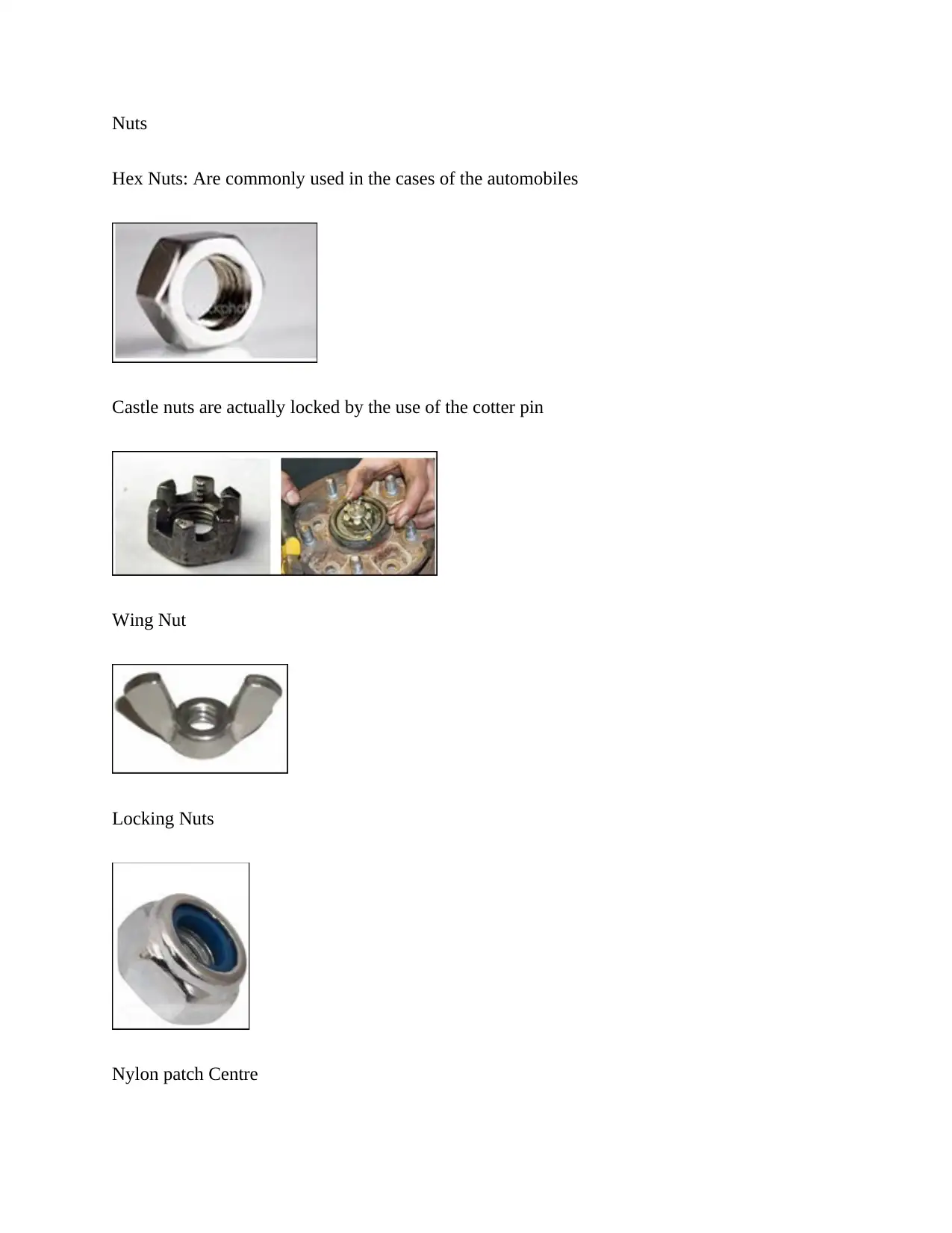
Nuts
Hex Nuts: Are commonly used in the cases of the automobiles
Castle nuts are actually locked by the use of the cotter pin
Wing Nut
Locking Nuts
Nylon patch Centre
Hex Nuts: Are commonly used in the cases of the automobiles
Castle nuts are actually locked by the use of the cotter pin
Wing Nut
Locking Nuts
Nylon patch Centre
Paraphrase This Document
Need a fresh take? Get an instant paraphrase of this document with our AI Paraphraser
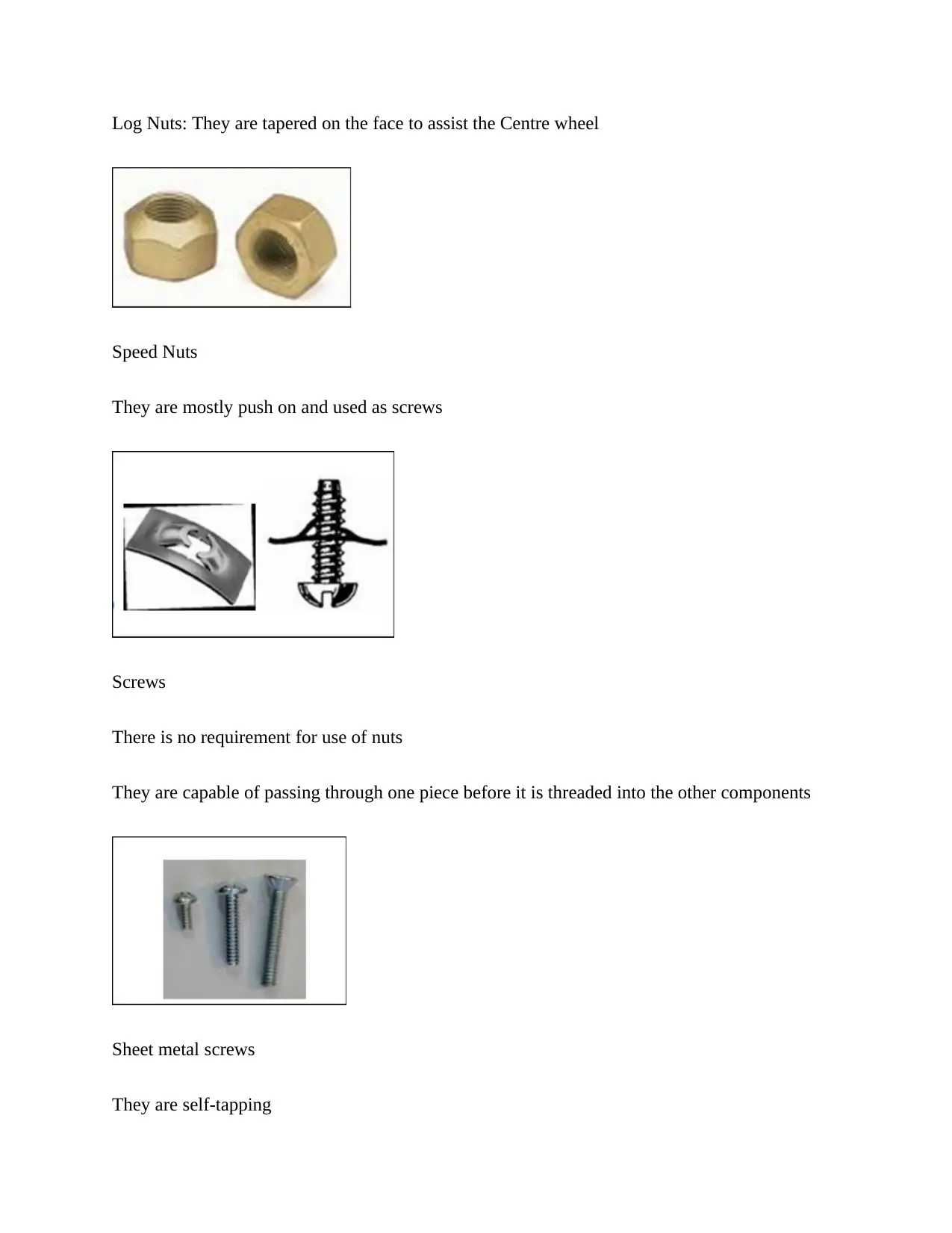
Log Nuts: They are tapered on the face to assist the Centre wheel
Speed Nuts
They are mostly push on and used as screws
Screws
There is no requirement for use of nuts
They are capable of passing through one piece before it is threaded into the other components
Sheet metal screws
They are self-tapping
Speed Nuts
They are mostly push on and used as screws
Screws
There is no requirement for use of nuts
They are capable of passing through one piece before it is threaded into the other components
Sheet metal screws
They are self-tapping
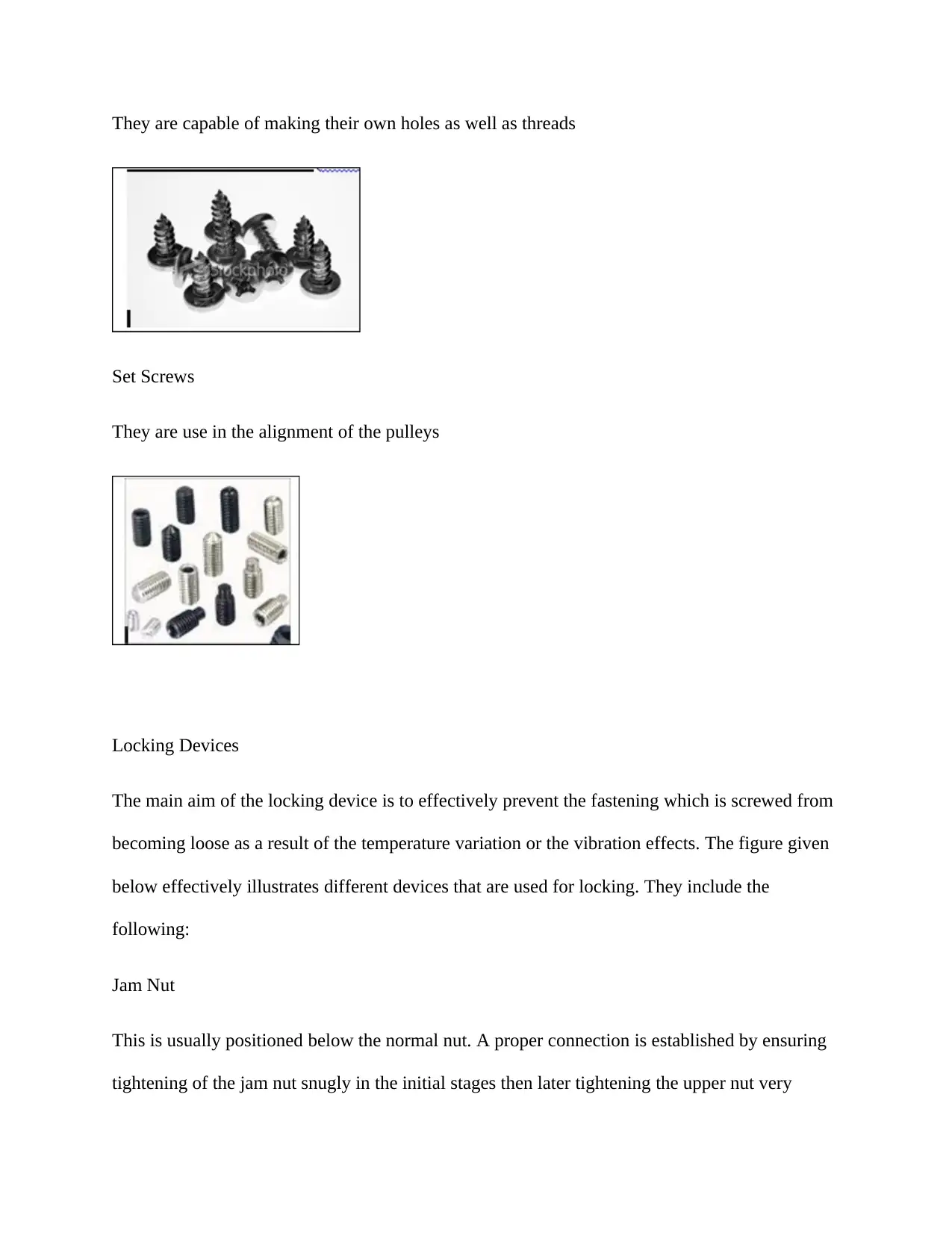
They are capable of making their own holes as well as threads
Set Screws
They are use in the alignment of the pulleys
Locking Devices
The main aim of the locking device is to effectively prevent the fastening which is screwed from
becoming loose as a result of the temperature variation or the vibration effects. The figure given
below effectively illustrates different devices that are used for locking. They include the
following:
Jam Nut
This is usually positioned below the normal nut. A proper connection is established by ensuring
tightening of the jam nut snugly in the initial stages then later tightening the upper nut very
Set Screws
They are use in the alignment of the pulleys
Locking Devices
The main aim of the locking device is to effectively prevent the fastening which is screwed from
becoming loose as a result of the temperature variation or the vibration effects. The figure given
below effectively illustrates different devices that are used for locking. They include the
following:
Jam Nut
This is usually positioned below the normal nut. A proper connection is established by ensuring
tightening of the jam nut snugly in the initial stages then later tightening the upper nut very
⊘ This is a preview!⊘
Do you want full access?
Subscribe today to unlock all pages.

Trusted by 1+ million students worldwide
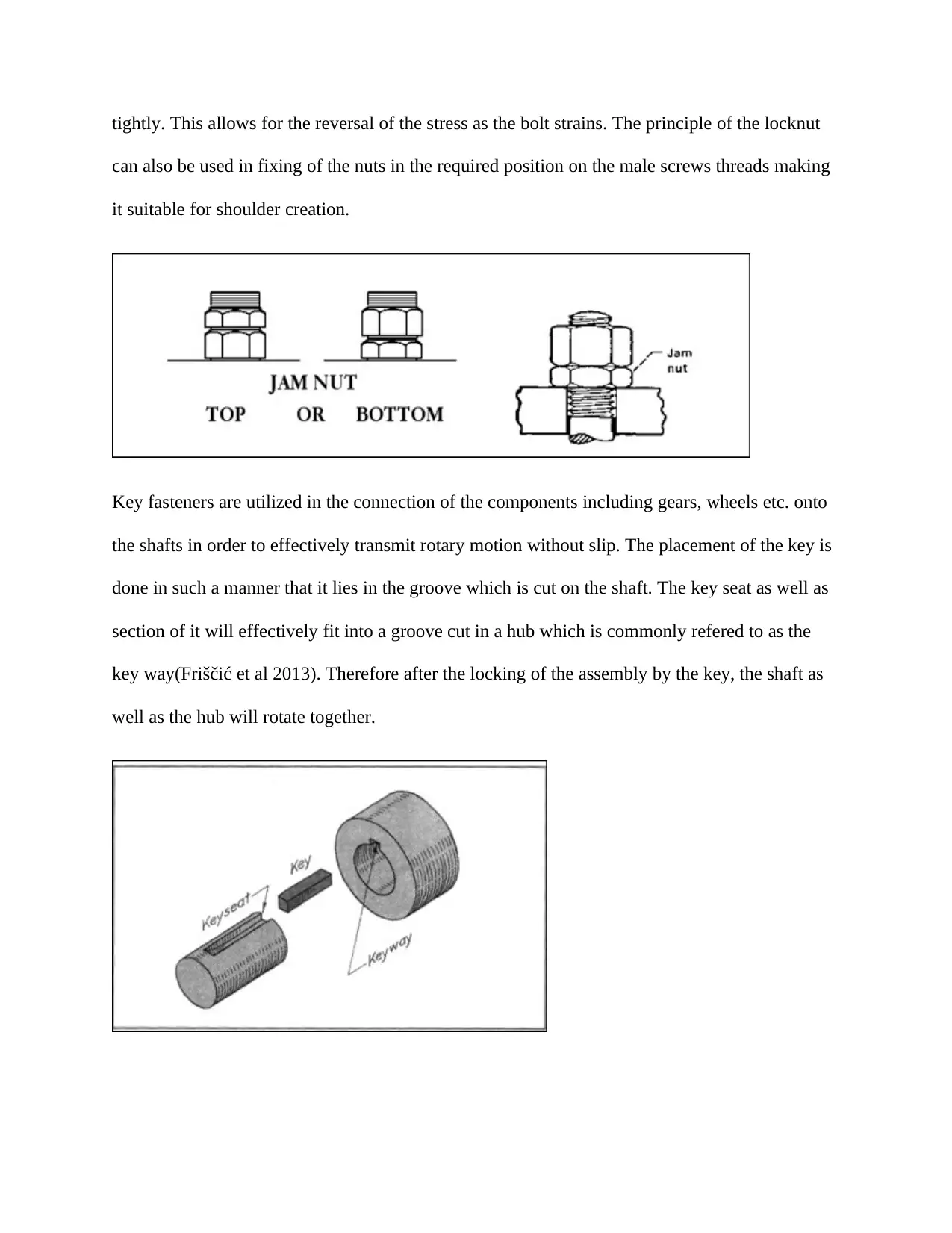
tightly. This allows for the reversal of the stress as the bolt strains. The principle of the locknut
can also be used in fixing of the nuts in the required position on the male screws threads making
it suitable for shoulder creation.
Key fasteners are utilized in the connection of the components including gears, wheels etc. onto
the shafts in order to effectively transmit rotary motion without slip. The placement of the key is
done in such a manner that it lies in the groove which is cut on the shaft. The key seat as well as
section of it will effectively fit into a groove cut in a hub which is commonly refered to as the
key way(Friščić et al 2013). Therefore after the locking of the assembly by the key, the shaft as
well as the hub will rotate together.
can also be used in fixing of the nuts in the required position on the male screws threads making
it suitable for shoulder creation.
Key fasteners are utilized in the connection of the components including gears, wheels etc. onto
the shafts in order to effectively transmit rotary motion without slip. The placement of the key is
done in such a manner that it lies in the groove which is cut on the shaft. The key seat as well as
section of it will effectively fit into a groove cut in a hub which is commonly refered to as the
key way(Friščić et al 2013). Therefore after the locking of the assembly by the key, the shaft as
well as the hub will rotate together.
Paraphrase This Document
Need a fresh take? Get an instant paraphrase of this document with our AI Paraphraser
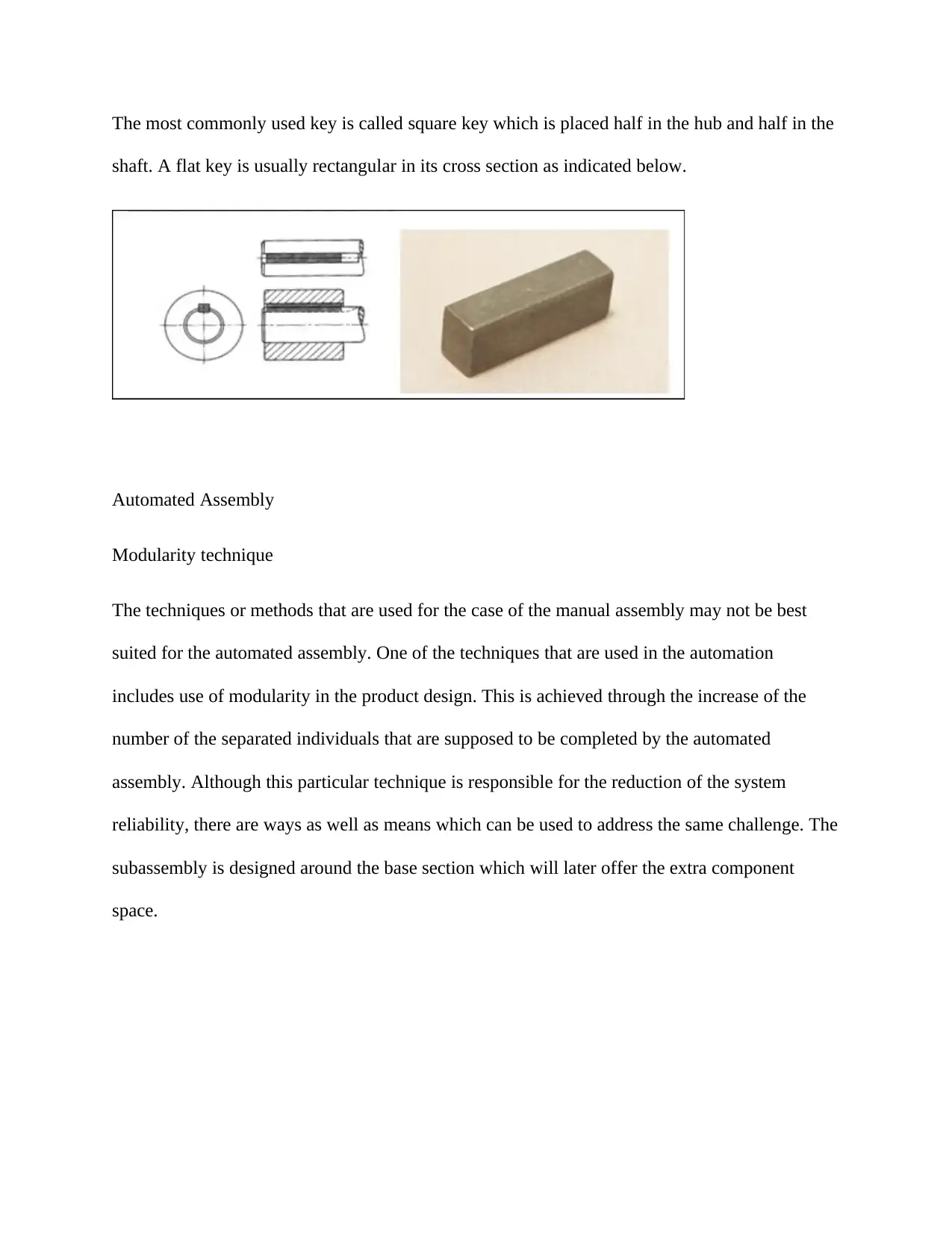
The most commonly used key is called square key which is placed half in the hub and half in the
shaft. A flat key is usually rectangular in its cross section as indicated below.
Automated Assembly
Modularity technique
The techniques or methods that are used for the case of the manual assembly may not be best
suited for the automated assembly. One of the techniques that are used in the automation
includes use of modularity in the product design. This is achieved through the increase of the
number of the separated individuals that are supposed to be completed by the automated
assembly. Although this particular technique is responsible for the reduction of the system
reliability, there are ways as well as means which can be used to address the same challenge. The
subassembly is designed around the base section which will later offer the extra component
space.
shaft. A flat key is usually rectangular in its cross section as indicated below.
Automated Assembly
Modularity technique
The techniques or methods that are used for the case of the manual assembly may not be best
suited for the automated assembly. One of the techniques that are used in the automation
includes use of modularity in the product design. This is achieved through the increase of the
number of the separated individuals that are supposed to be completed by the automated
assembly. Although this particular technique is responsible for the reduction of the system
reliability, there are ways as well as means which can be used to address the same challenge. The
subassembly is designed around the base section which will later offer the extra component
space.
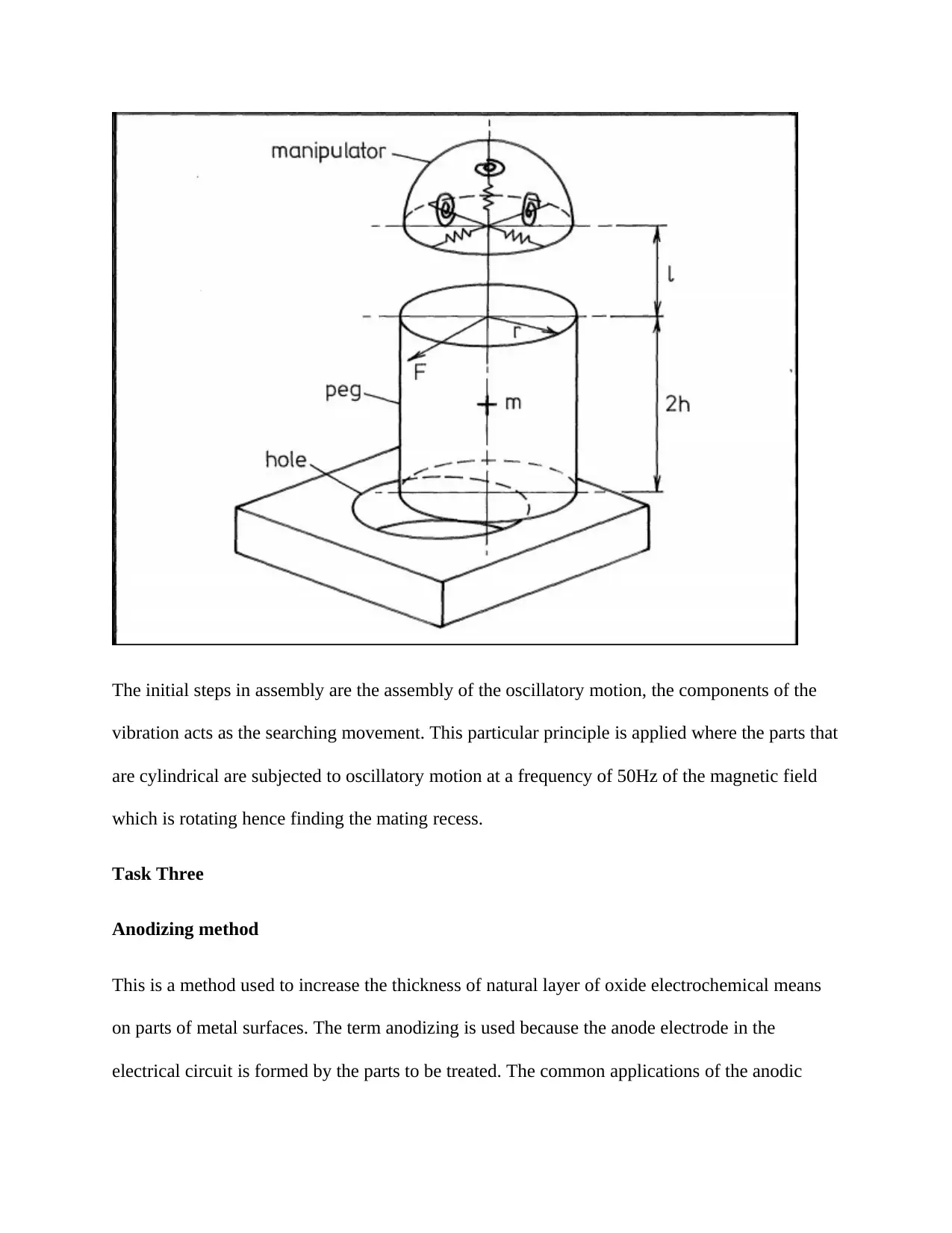
The initial steps in assembly are the assembly of the oscillatory motion, the components of the
vibration acts as the searching movement. This particular principle is applied where the parts that
are cylindrical are subjected to oscillatory motion at a frequency of 50Hz of the magnetic field
which is rotating hence finding the mating recess.
Task Three
Anodizing method
This is a method used to increase the thickness of natural layer of oxide electrochemical means
on parts of metal surfaces. The term anodizing is used because the anode electrode in the
electrical circuit is formed by the parts to be treated. The common applications of the anodic
vibration acts as the searching movement. This particular principle is applied where the parts that
are cylindrical are subjected to oscillatory motion at a frequency of 50Hz of the magnetic field
which is rotating hence finding the mating recess.
Task Three
Anodizing method
This is a method used to increase the thickness of natural layer of oxide electrochemical means
on parts of metal surfaces. The term anodizing is used because the anode electrode in the
electrical circuit is formed by the parts to be treated. The common applications of the anodic
⊘ This is a preview!⊘
Do you want full access?
Subscribe today to unlock all pages.

Trusted by 1+ million students worldwide
1 out of 24
Related Documents
Your All-in-One AI-Powered Toolkit for Academic Success.
+13062052269
info@desklib.com
Available 24*7 on WhatsApp / Email
![[object Object]](/_next/static/media/star-bottom.7253800d.svg)
Unlock your academic potential
Copyright © 2020–2025 A2Z Services. All Rights Reserved. Developed and managed by ZUCOL.





